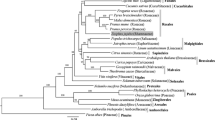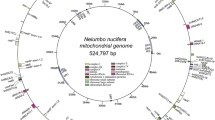Abstract
Compared to organelle genomes, the nuclear genome comprises a vast reservoir of genes that potentially harbor phylogenetic signal. Despite the valuable data that sequencing projects of model systems offer, relatively few single-copy nuclear genes are being used in systematics. In part this is due to the challenges inherent in generating orthologous sequences, a problem that is ameliorated when the gene family in question has been characterized in related organisms. Here we illustrate the utility of diverse sequence databases within the Asteraceae as a framework for developing single-copy nuclear genes useful for inferring phylogenies in the tribe Senecioneae. We highlight the process of searching for informative genes by using data from Helianthus annuus, Lactuca sativa, Stevia rebaudiana, Zinnia elegans, and Gerbera cultivar. Emerging from this process were several candidate genes; two of these were used for a phylogenetic assessment of the Senecioneae and were compared to other genes previously used in Asteraceae phylogenies. Based on the preliminary sampling used, one of the genes selected during the searching process was more useful than the two previously used in Asteraceae. The search strategy described is valid for any group of plants but its efficiency is dependent on the phylogenetic proximity of the study group to the species represented in sequence databases.








Similar content being viewed by others
References
Altschul SF, Gish W, Miller W, Myers EW, Lipman DJ (1990) Basic Local Alignment Search Tool. J Mol Biol 215:403–410
Álvarez I, Cronn R, Wendel JF (2005) Phylogeny of the New World diploid cottons (Gossypium L., Malvaceae) based on sequences of three low-copy nuclear genes. Plant Syst Evol 252:199–214
Álvarez I, Wendel JF (2003) Ribosomal ITS sequences and plant phylogenetic inference. Mol Phylogenet Evol 29:417–434
Baldauf SL (1999) A search for the origins of animals and fungi: comparing and combining molecular data. Am Nat 154:S178–S188
Bininda-Emonds ORP (2004) The evolution of supertrees. Trends Ecol Evol 19:315–322
Brown JR (2001) Genomic and phylogenetic perspectives on the evolution of prokaryotes. Syst Biol 50:497–512
Chase MW, Soltis DE, Olmstead RG, Morgan D, Les DH, Mishler BD, Duvall MR, Price RA, Hills HG, Qiu YL, Kron KA, Rettig JH, Conti E, Palmer JD, Manhart JR, Sytsma KJ, Michaels HJ, Kress WJ, Karol KG, Clark WD, Hedren M, Gaut BS, Jansen RK, Kim KJ, Wimpee CF, Smith JF, Furnier GR, Strauss SH, Xiang QY, Plunkett GM, Soltis PS, Swensen SM, Williams SE, Gadek PA, Quinn CJ, Eguiarte LE, Golenberg E, Learn GH, Graham SW, Barrett SCH, Dayanandan S, Albert VA (1993) Phylogenetics of seed plants—an analysis of nucleotide-sequences from the plastid gene rbcl. Ann Mo Bot Gard 80:528–580
Cronn R, Small RL, Haselkorn T, Wendel JF (2002) Rapid diversification of the cotton genus (Gossypium: Malvaceae) revealed by analysis of sixteen nuclear and chloroplast genes. Am J Bot 89:707–725
Cronn R, Small RL, Haselkorn T, Wendel JF (2003) Cryptic repeated genomic recombination during speciation in Gossypium gossypioides. Evolution 57:2475–2489
Fulton TM, Van der Hoeven R, Eannetta NT, Tanksley SD (2002) Identification, analysis, and utilization of conserved ortholog set markers for comparative genomics in higher plants. Plant Cell 14:1457–1467
Fortune PM, Schierenbeck KA, Ainouche AK, Jacquemin J, Wendel JF, Ainouche ML (2007) Evolutionary dynamics of Waxy and the origin of hexaploid Spartina species (Poaceae). Mol Phylogenet Evol 43:1040–1055
Graham SW, Olmstead RG (2000) Utility of 17 chloroplast genes for inferring the phylogeny of the basal angiosperms. Am J Bot 87:1712–1730
Hall TA (1999) BioEdit: a user-friendly biological sequence alignment editor and analysis program for Windows 95/98/NT. Nucleic Acids Symp Ser 41:95–98
Hare MP (2001) Prospects for nuclear gene phylogeography. Trends Ecol Evol 16:700–706
Hassanin A (2006) Phylogeny of Arthropoda inferred from mitochondrial sequences: strategies for limiting the misleading effects of multiple changes in pattern and rates of substitution. Mol Phylogenet Evol 38:100–116
Helariutta Y, Kotilainen M, Elomaa P, Kalkkinen N, Bremer K, Teeri TH, Albert VA (1996) Duplication and functional divergence in the chalcone synthase gene family of Asteraceae: evolution with substrate change and catalytic simplification. Proc Natl Acad Sci USA 93:9033–9038
Jansen RK, Holsinger KE, Michaels HJ, Palmer JD (1990) Phylogenetic analysis of chloroplast DNA restriction site data at higher taxonomic levels - an example from the Asteraceae. Evolution 44:2089–2105
Jansen RK, Michaels HJ, Palmer JD (1991) Phylogeny and character evolution in the Asteraceae based on chloroplast DNA restriction site mapping. Syst Bot 16:98–115
Kadereit JW, Jeffrey C (1996) A preliminary analysis of cpDNA variation in the tribe Senecioneae (Compositae). In: Hind DJN, Beentje HJ (eds) Compositae: systematics. Proceedings of the International Compositae Conference, Kew, 1994. Royal Botanic Gardens, Kew, pp 349–360
Kim KJ, Jansen RK (1995) Ndhf sequence evolution and the major clades in the sunflower family. Proc Natl Acad Sci USA 92:10379–10383
Kim KJ, Jansen RK, Wallace RS, Michaels HJ, Palmer JD (1992) Phylogenetic implications of rbcL sequence variation in the Asteraceae. Ann Mo Bot Gard 79:428–445
Knox EB, Kowal RR (1993) Chromosome-numbers of the East-African giant Senecios and giant Lobelias and their evolutionary significance. Am J Bot 80:847–853
Lawrence ME (1980) Senecio L (Asteraceae) in Australia—chromosome numbers and the occurrence of polyploidy. Aust J Bot 28:151–165
Liu JQ (2004) Uniformity of karyotypes in Ligularia (Asteraceae: Senecioneae), a highly diversified genus of the eastern Qinghai-Tibet Plateau highlands and adjacent areas. Bot J Linn Soc 144:329–342
López MG, Wulff AF, Poggio L, Xifreda CC (2005) Chromosome numbers and meiotic studies in species of Senecio (Asteraceae) from Argentina. Bot J Linn Soc 148:465–474
Mathews S, Donoghue MJ (1999) The root of angiosperm phylogeny inferred from duplicate phytochrome genes. Science 286:947–950
Mayol M, Rosselló JA (2001) Why nuclear ribosomal DNA spacers (ITS) tell different stories in Quercus. Mol Phylogenet Evol 19:167–176
Mort ME, Crawford DJ (2004) The continuing search: low-copy nuclear sequences for lower-level plant molecular phylogenetic studies. Taxon 53:257–261
Nei M, Li WH (1979) Mathematical-model for studying genetic-variation in terms of restriction endonucleases. Proc Natl Acad Sci USA 76:5269–5273
Nordenstam B (1977) Senecioneae and Liabeae—systematic review. In: Harborne JB, Turner BL (eds) The biology and chemistry of the Compositae. Academic Press, London, pp 799–830
Nozaki H, Matsuzaki M, Takahara M, Misumi O, Kuroiwa H, Hasegawa M, Shin-i T, Kohara Y, Ogasawara N, Kuroiwa T (2003). The phylogenetic position of red algae revealed by multiple nuclear genes from mitochondria-containing eukaryotes and an alternative hypothesis on the origin of plastids. J Mol Evol 56:485–497
Pelser PB, Nordenstam B, Kadereit JW, Watson LE (2007) An ITS phylogeny of the tribe Senecioneae (Asteraceae) and a new delimitation of Senecio L. Taxon 56:1077–1104
Razafimandimbison SG, Kellogg EA, Bremer B (2004) Recent origin and phylogenetic utility of divergent ITS putative pseudogenes: a case study from Naucleeae (Rubiaceae). Syst Biol 53:177–192
Sambrook J, Fritsch EF, Maniatis T (1989) Molecular cloning: Aa laboratory manual. Cold Spring Harbor Press, Cold Spring Harbor, NY
Sang T (2002) Utility of low-copy nuclear gene sequences in plant phylogenetics. Crit Rev Biochem Mol 37:121–147
Schlegel M (2003) Phylogeny of eukaryotes recovered with molecular data: highlights and pitfalls. Eur J Protistol 39:113–122
Schlüter PM, Stuessy T, Paulus HF (2005) Making the first step: practical considerations for the isolation of low-copy nuclear sequence markers. Taxon 54:766–770
Senchina DS, Álvarez I, Cronn RC, Liu B, Rong J, Noyes RD, Paterson AH, Wing RA, Wilkins TA, Wendel JF (2003) Rate variation among nuclear genes and the age of polyploidy in Gossypium. Mol Biol Evol 20:633–643
Small RL, Cronn R, Wendel JF (2004) Use of nuclear genes for phylogeny reconstruction in plants. Aust Syst Bot 17:145–170
Soltis PS, Soltis DE, Chase MW (1999) Angiosperm phylogeny inferred from multiple genes as a tool for comparative biology. Nature 402:402–404
Strand AE, LeebensMack J, Milligan BG (1997) Nuclear DNA-based markers for plant evolutionary biology. Mol Ecol 6:113–118
Swofford DL (1999) PAUP*. Phylogenetic Analysis Using Parsimony (*and other methods). Version 4.02b. Sinauer, Sunderland, MA
Van de Peer Y, De Wachter R (1997) Evolutionary relationships among the eukaryotic crown taxa taking into account site-to-site rate variation in 18S rRNA. J Mol Evol 45:619–630
Van de Peer Y, Neefs JM, De Wachter R (1990) Small ribosomal subunit RNA sequences, evolutionary relationships among different life forms, and mitochondrial origins. J Mol Evol 30:463–476
Wu F, Mueller LA, Crouzillat D, Pétiard V, Tanksley SD (2006) Combining bioinformatics and phylogenetics to identify large sets of single copy, orthologous genes (COSII) for comparative, evolutionary and systematic studies: a test case in the Euasterid plant clade. Genetics 174(3):1407–1420
Zhang DX, Hewitt GM (2003) Nuclear DNA analyses in genetic studies of populations: practice, problems and prospects. Mol Ecol 12:563–584
Acknowledgments
We thank J. F. Wendel for valuable comments on the manuscript, B. Nordenstam and P. B. Pelser for criticism of the experimental design and sampling, R. W. Michelmore for permission to use sequences from the Compositae Genome Project, C. Cotti for lab work, P. B. Pelser for DNA samples, J. Castresana for advice on search protocols, and A. Herrero, J. Leralta, L. Medina, and B. Nordenstam for plant material. This work was funded by the Spanish Ministry of Education and Science (CGL2004-03872).
Author information
Authors and Affiliations
Corresponding author
Electronic supplementary material
Below is the link to the electronic supplementary material.
Rights and permissions
About this article
Cite this article
Álvarez, I., Costa, A. & Feliner, G.N. Selecting Single-Copy Nuclear Genes for Plant Phylogenetics: A Preliminary Analysis for the Senecioneae (Asteraceae). J Mol Evol 66, 276–291 (2008). https://doi.org/10.1007/s00239-008-9083-7
Received:
Revised:
Accepted:
Published:
Issue Date:
DOI: https://doi.org/10.1007/s00239-008-9083-7




